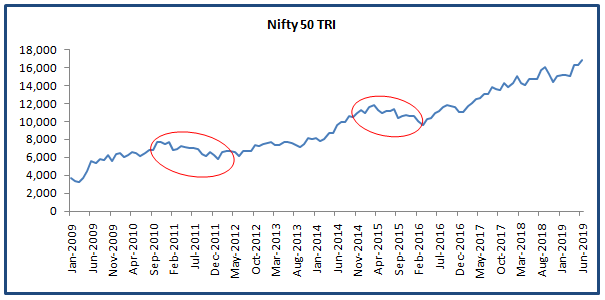What should the ideal tenure of a STP in Large Cap Mutual Funds

Systematic Transfer Plan (STP) is a mutual fund investment plan in which you can invest your lump sum money in a low risk mutual fund scheme, usually liquid fund and then transfer systematically fixed amounts every month (or any other interval) to the equity fund of your choice in the same AMC. STP is a defence against volatility because you can average the acquisition costs of your equity fund units in volatile market conditions. Through the tenure of your STP you also get returns from your liquid funds (on a diminishing balance basis), which can be reinvested in the equity fund. We have often received queries from many investors asking recommended tenures for STP. Different STP tenures will give different results depending on market conditions.
Suggested reading: Thinking of lump sum investments in mutual funds: What about STP
In this blog post, we will try to see if investors can get some general guidance from historical corrections and recoveries.
Dilemma of STP tenures
Investors usually initiate STPs when they want to invest during corrections and are not sure how long the correction will last. To be on the safe side you may want to have a long STP tenure, but there is a hockey stick shaped recovery, then you will be purchasing units of equity funds at higher and higher price with every STP instalment. The benefit of longer STP tenures is higher returns accrued from the liquid fund, but your higher cost of acquisition of equity fund units will negate the incremental returns from the liquid fund. On the other hand, if your STP tenure is too short and the correction is deeper or lasts longer than you anticipated then there is not only the risk of making short term losses but also opportunity lost to lower your acquisition cost while accruing returns from the liquid fund. So what should you do?
Historical corrections
Let us look at the major correction in our frontline market index, Nifty 50 TRI over the past 10 years. There were two major corrections (20% or more) in Nifty over the last 10 years (please see the portion of the Nifty 50 TRI chart circled in red). The lengths of the two corrections in 2011 and 2015 -16 were approximately the same (give or take a couple of months). However, the rally from the market bottom in 2016 was stronger.

How would STPs of different tenures have performed during these two corrections?
Let us assume you had Rs 10 Lakhs lump sum funds. When the market corrected 20% in 2011 and 2015 - 16, you invested the amount in a liquid fund and transferred equal amounts every month to Nifty 50 TRI over 3 different STP tenures 3 months, 6 months and 12 months. For the sake of simplicity let us assume you get 6% annualized returns from your liquid fund. First let us see how much returns we would have accrued from the liquid fund over different STP tenures (assumption the first STP instalment to equity fund is debited on the lump sum investment date).

Let us now see how many Nifty 50 units you would have been able to purchase over different STP tenures during the 2011 correction and their values 3 years later. We are assuming the liquid fund returns are re-invested in the Nifty 50 TRI. Please note that we begin our STP when the market has corrected 20% from its previous peak.
Investment Start Date: 3rd October 2011

Source: Source: NSE Data
Clearly by spreading out your STP over 12 months, you made lower profits since you average acquisition cost higher during the recovery. Also note that the difference in profit in your 6 month STP is not much more than your 3 month STP.
Let us now see how many Nifty 50 units you would have been able to purchase over different STP tenures during the 2015 correction and their values 3 years later. Again, please note that we begin our STP when the market has corrected 20% from its previous peak.
Investment Start Date: 3rd March 2016

Source: Source: NSE Data
Like in the previous case 12 month STP gave the worst result. 3 month STP gives significantly better result than 6 months and 12 months STP. This is because 2015-16 correction was less severe than the 2011 correction and the recovery was also faster.
Suggested reading: 10 things you should do in volatile markets
Our take
The two examples showed us that 3 – 6 months STP is better than a long term (12 months or longer) STP. Historical bear markets (excluding extreme ones like 2008) in India did not last for more than 12 months. If you begin your STP when significant price damage has already been done, the recovery will begin much before 12 months. Should you go for 3 month or 6 month STP? Prima facie, based on the results of our analysis, 3 month STP seems to be a better option. However, you can also start a 6 month STP and if you feel confident about the recovery, you can always stop your STP by writing to the AMC and switching your balance liquid fund units to the equity fund. In this post, we discussed about STP tenures for Nifty 50, which is a large cap index. What should be your STP tenure in midcaps which are more volatile in nature? We will discuss it in our next post. Stay tuned.......
Mutual Fund Investments are subject to market risk, read all scheme related documents carefully.
RECOMMENDED READS
LATEST ARTICLES
- Why you need to have hybrid mutual funds in your portfolio: Different types of funds Part 2
- Why you need to have hybrid mutual funds in your portfolio: Misconceptions Part 1
- Which is the best time to invest in mutual funds
- Economic slowdown: Is it real and what should you do
- Importance of liquidity in investing: Mutual funds are ideal solutions
An Investor Education Initiative by ICICI Prudential Mutual Fund to help you make informed investment decisions.
Quick Links
Follow ICICI Pru MF
More About ICICI Pru MF
POST A QUERY




